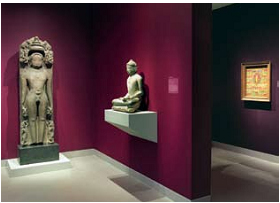
Centre of Jaina Studies Newsletter: SOAS - University of London
In conjunction with the exhibit Victorious Ones: Jain Images of Perfection, curated by Phyllis Granoff and on display at the Rubin Museum of Art in New York from 18 September 2009 to 15 February 2010, Yale University hosted a symposium on Jaina art from 13-14 November 2009. Scholars from various disciplines and areas of interest presented thirteen thought-provoking papers.
Nalini Balbir (University of Paris, Sorbonne) gave the keynote lecture on Friday evening, reading her paper, "The 'Kalpasūtra' Network Revisited: Text, Commentaries, Manuscripts and Manuscript Painting." Her detailed study of various illustrated manuscripts of the Kalpasūtra demonstrated how examining the manuscripts' colophons, textual narratives, and images can highlight the role of artists, sectarian controversies, and elite monks in the production of these documents. Colophons show that the 14th-century head of the Kharatara Gaccha, Jinaprabhasūri, had an influential role in the production of illustrated Kalpasūtra manuscripts. Images in these manuscripts do not always relate to the text, however, and often represent narratives from completely distinct texts, highlighting the artists' roles in developing their own canon of reference. Many manuscripts devote multiple images to the story of the transfer of Mahāvīra's embryo, illustrating Śvetāmbaras' desire to emphasize this occurrence as the sixth kalyāṇaka in the face of Digambara rejection of the event.
Phyllis Granoff (Yale University) began the daylong session on Saturday with her paper, "Bewitching Beauty: Some Jain Reflections on Art," which discussed some ways in which Jains, both Digambara and Śvetāmbara, have written about the power of Jina images and the dangers of other works of art. While numerous texts relate how the sight of a Jina icon can incite conversions to Jainism, some texts note the dangers of images other than the Jina. The Brhatkalpasūtra, a text on mendicant conduct, and its 6th-century commentary, the Bṛhatkalpabhāṣya, forbid mendicants from staying in residences with paintings. This text warns that representations of humans, animals, and gods can rouse emotions and may become inhabited by demigods who could disrupt mendicants' austerities.
With "Situating Darśan: Seeing the Digambar Jina Icon in Eighteenth and Nineteenth Century North India," John Cort (Denison University) offered a close reading of Digambara worship manuals and vernacular hymns (darśana pāṭha) in order to expand the scholarly understanding of 'darśan' beyond the familiar 'seeing and being seen by the deity' formula. Cort concentrated on the hymns sung for darśan by contemporary Digambara Jains in Jaipur, especially those composed by Bhūdhardās (c.1700- c.1765), Budhjan (c.1763-c.1838), and Daulatrām (c. 1798-c.1866). These hymns, some called vinati (modest petitions), do not focus on the mutual gaze of the Jina and worshiper, but instead emphasize the failings of the devotee and the glory of the Jina.

Victorious Ones: Jain Images of Perfection, at the Rubin Museum of Art in New York City, 18 September 2009 to 15 Febraury 2010. Photo by Steven Wiliams, Courtesy of the Rubin Museum of Art
Whitney Kelting (Northeastern University) next presented her paper, "Jain Stavan and the Imagination of a Jain Landscape." She discussed how contemporary Śvetāmbara Jains forge links between specific Jina icons at pilgrimage sites in Gujarat and the Jina images at their local temples through the recitation of popular hymns (stavan). Kelting focused on four hymns in particular, "Śrī Śaṅkeśvār" and "Śaṅkeśvār Dādā" which honor the Pārśvanātha image at Śaṅkeśvār, "Jinajī Pyārā" which eulogizes the icon of Ādinātha at Śatruñjaya, and "Ajitnāth Jineśvar," which venerates the Ajitanātha temple at Tāraṅgā. Kelting suggested that the regular recitation of these stavans at home temples allows Jains to map the power of these miracle-working images onto local Jina icons.
In "Sacred Space in the Modern and Contemporary Śatruñjaya Paṭa," Hawon Ku (Hankuk University of Foreign Studies, Seoul) argued that 19th-century evolutions in cloth paintings (paṭa) of the Gujarat pilgrimage site Śatruñjaya illustrate a formation of a modern Jain identity. Compared to earlier, smaller, abstract representations of Satruñjaya produced from the 15th to 19th centuries, Satruñjaya paṭas created from the 19th century onwards became larger and represented the pilgrimage site more realistically. Ku argued that this map-like realistic portrayal of Śatruñjaya stemmed from Jains' desire to demonstrate a possession of the site amongst legal arguments with Hindus over ownership of the site throughout the 19th century.
Dipti Khera (Columbia University) spoke on "Painted Travel Invitations, Poems, and Singing about Urban Locales: Visualizing Udaipur within Jain Vijñaptipatras and Gajals in the Mid 18th-early 19th Century," revealing the wealth of information that painted travel invitations (vijñaptipatra) contain about urban life in Rajasthan in the 18th and 19th centuries. The vijñaptipatra Khera examined, sent by the Śvetāmbara community of Udaipur to invite the monk Śrī Jinaharṣa Sūri to their city for the 1830 rainy season, represented all aspects of Udaipur - from shops to diverse religious institutions. Khera also noted the similarities between these paintings and Rajasthani court paintings.
In "Visualizing Jaina Pilgrimage: Sacred Centres, Temple Cities and Tīrtha Paṭas," Julia Hegewald (University of Manchester) gave an overview of some popular structures that formally construct and transform sites into pilgrimage sites, both Śvetāmbara and Digambara. She discussed how replications of these structures in their original size, as miniature models, and in cloth paintings (paṭa) allow pilgrimage practices to transcend the original location of the structures. Highlighting sites throughout the subcontinent, such as a replica of Śatruñjaya in Delhi, she noted the increasing reproduction, in full-size and silver models, of the Jal Mandir (water temple) at Pāvāpurī in Bihar and the growing popularity of representing Nandīśvara-dvīpa.
With "Worshipping the Jina Parśvanātha at Ellora," Lisa Owen (University of North Texas) examined the worship of images of Parśvanātha at Ellora from the establishment of the earliest Ellora Jain cave shrines in the 9th and 10th centuries until the present day. While not the focus of any main shrine, Parśvanātha is portrayed in Ellora wall reliefs, pillars, etc. over forty-five times. Reliefs portray deities and humans worshiping the Jina, including at least three images that appear to be advanced lay devotees (two brahmacārins, one āriykā). Owen also discussed the contemporary worship of a 13-foot-tall Digambara Parśvanātha image constructed in the thirteenth century a short distance from Ellora's main monuments.
Janice Leoshko (University of Texas at Austin), reading her paper, " 'Artfully Carved': Jain Imagery in Orissa," presented some areas of future research for students of the Udayagiri and Khaṇḍagiri rock-cut caves in Orissa, parts of which date from c.1st century BCE. Critiquing scholarship that discusses Indian art in isolation, Leoshko encouraged scholars to analyze the images of Udayagiri and Khaṇḍagiri in context. Some representations of tree worship and an image of the deity Sūrya at the caves should not be studied on their own, but in terms of their locations above the entrances of dwelling places for Jain mendicants.
With "The 'Jackal-like Jains' of Southern Gopakṣetra: Archaeological Traces in the Rural Periphery," Tamara Sears (Yale University) discussed some formative interactions between religious communities in Madhya Pradesh, in particular the area along the Mahuar river, around the 10th and 11th centuries. While Śaiva groups dominated this region from the 7th to 9th centuries, Digambara Jain shrines, along with Śākta and Vaiṣṇava sites, began to appear in the 10th and 11th centuries. Sears suggested that the Mahuar river, as a link between the Betwa and Sind rivers, might not only have brought the new communities to the region, but could have fostered interactions between rival religious groups, as she illustrated with examples of similar iconographical schemes of Śaiva and Jain temples of the area.
With "Contemporary Jains and Newly Built Temples," Catherine Asher (University of Minnesota) presented the beginnings of a project on newly constructed Jain temples, both Digambara and Śvetāmbara, in Delhi, Ajmer, Jaipur, Hisar, and Aligarh. Asher discussed both local temples, such as the new Digambara temple in Vasant Kunj in south Delhi, along with temples promoted as pilgrimage sites such as Ācārya Suśīl Kumar's samādhi site near Defense Colony in Delhi. Along with highlighting some of the architectural features of the temples, Asher investigated the motivations of the wealthy, well-educated Jains who promote the construction of these structures to foster networks and promote their understandings of Jainism.
Independent scholar Robert Del Bontà's paper, "Illustrating Victorious Lives: Jaina Narrative Painting" studied some of the uniformities and differences between Digambara and Śvetāmbara pictorial representations of the lives of the Jinas. Del Bontà examined images from both individual paintings and illustrated manuscripts such as various Ādipurāṇas and Kalpasūtras. Highlighting depictions of Indra's lustration of infant Jinas (janmābhiṣeka), Del Bontà noted that unlike in Śvetāmbara depictions, Digambara versions consistently show Indra riding an elephant. Scenes of Ṛṣabha's coronation (rājyābhiṣeka) also differ, as Digambaras depict Indra lustrating the future Jina's head, and Śvetāmbaras have them either lustrating his feet or simply applying a tilak to his forehead. While some of these differences have textual precedents, others are the product of an artistic tradition.
The last presenter of the symposium, Elena Preda (University of Bologna), spoke on "The Contribution of Jain Art to the Sirohi School of Painting," examining Jain influence on the Sirohi school of painting that emerged in the 17th century in the Rajasthan state of Sirohi along the Gujarat-Rajasthan border. Preda studied some miniature paintings illustrating an 18th-century Devīmahātmya manuscript, noting that the style of these paintings, which depict the goddess within a śrī yantra, or intersecting triangles, bears great resemblance to an earlier Śvetāmbara Jain yantra published in the catalogue of the 1995 exhibition The Peaceful Liberators. This diagram also pictures a goddess within intersecting triangles. The concluding remarks given by Osmund Bopearachchi (CNRS, Yale University) and Sonya Quintanilla (San Diego Museum of Art) no doubt expressed the sentiments of all the symposium participants when they thanked Phyllis Granoff for arranging this forum in which an interdisciplinary group of scholars could present diverse perspectives on Jain art, an understudied area of research that deserves recognition.
Ellen Gough MA, SOAS Department of the Study of Religions, now a PhD student at Yale University in the Department of Religious Studies, was holder of the 2007 Jain Spirit Fellowship in Jaina Studies at SOAS. Her work on the Ṛṣimaṇḍala Yantra was awarded the IOJ sponsored Centre of Jaina Studies Dissertation Prize 2008.
 Dr. Ellen Gough
Dr. Ellen Gough